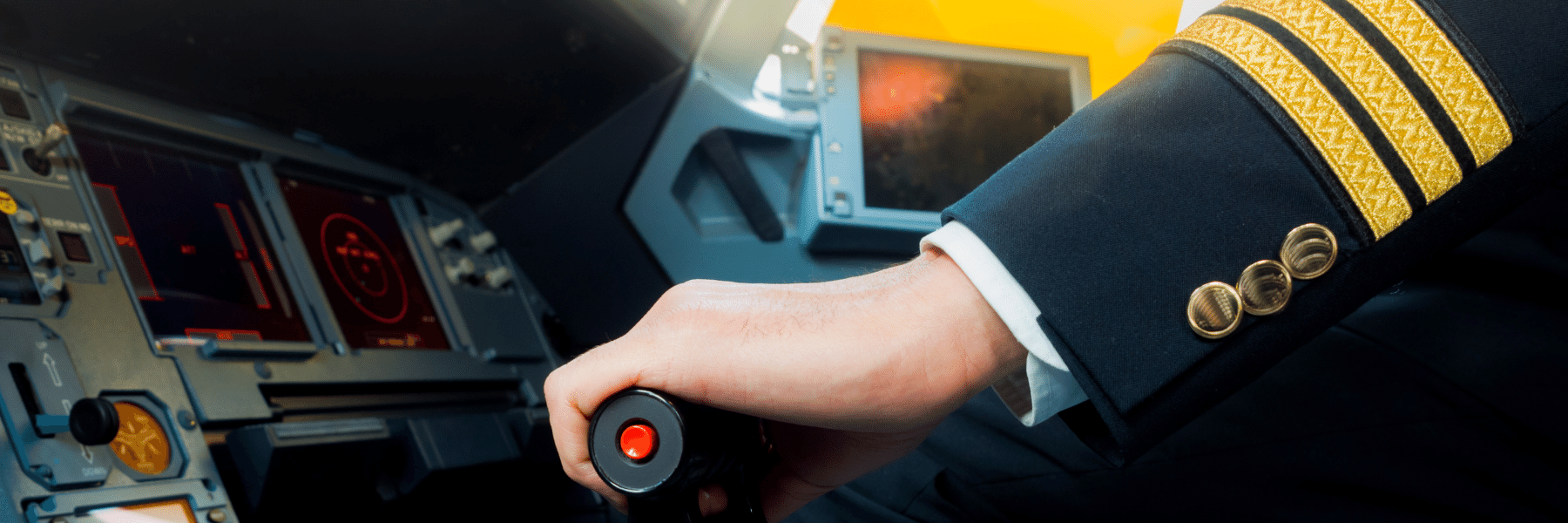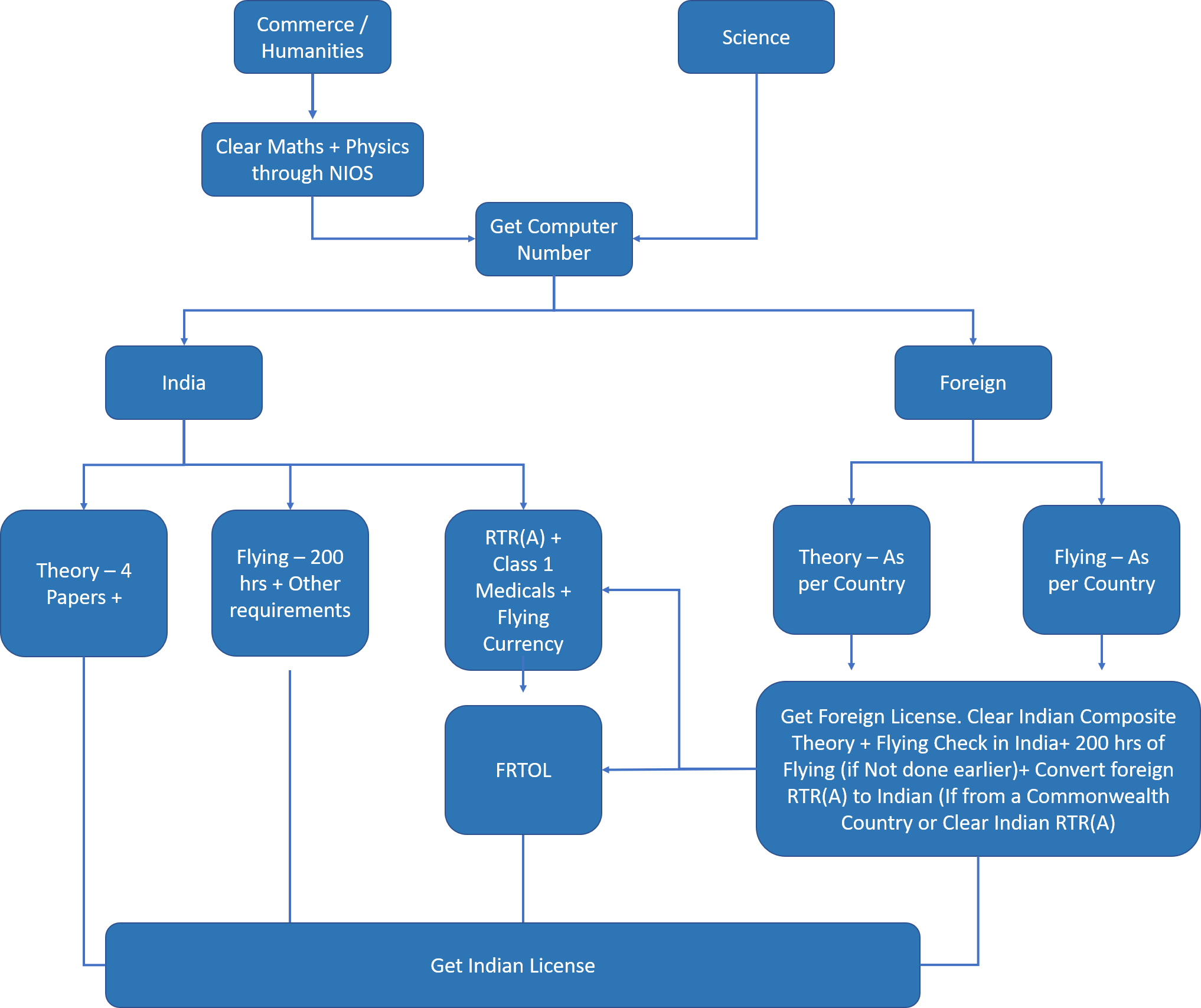Becoming a Pilot in India
Many dream of becoming a pilot. So here is the way forward. It is a requirement based process. Think about getting a driving license. There are certain requirements to be fulfilled like you should first get a learners license by meeting age criteria and pass an exam. Then you do your driving training and after 6 months or so you get a license from your RTO. Similarly, the agency that gives Pilot License in India is DGCA or Director General Civil Aviation which is central regulator for all civil aviation in India.
Types Licenses and Requirements
A. Student Pilot License
1.Age: Minimum 16 years old
2. Minimum qualification of 10th standard.
3. Medical fitness of Class
4. Eligible to only fly for training purpose.

B. Private Pilot License
1.Age: Minimum 17 years old
2. Minimum of 40 hours of flying experience.
3. Minimum qualification of 10th standard.
4. Medical fitness of Class 2.
5. Eligible to fly for personal
use only. Cannot be used for enumeration.
6. Should clear the required DGCA papers.

C. Commercial Pilot License
Age - Minimum 18 years
Education - 10+2 with Physics & Maths
Ground Exams - Navigation, Air regulations, Technical General & Meteorology.
Flying Experience - 200 hrs
Medical - Class 1
Valid FRTOL
Computer Number.
This is the first step towards getting a Pilot License in India. This number is used for Registering and appearing for theory exam and is valid for lifetime.

Documents required
• Applicant’s Photograph
• Applicant’s Signature
• 10th and 12th Marksheets
• 10th and 12th Pass Certificate
• 10th and 12th Board Verification
• Copy of Proof of Permanent Address
• Aadhar Card
• Passport
Medical Fitness for Pilot License
Class 2 Medical
The minimum medical fitness required to be a pilot. Valid for 2 years. Required for SPL and PPL.
Class 1 Medical
a. Valid for 1 year. b. Has to be renewed every year before it expires. c. Required for CPL and ATPL.
Academic Qualification for an Indian Pilot License
Details
1. If you do not have 10+2 with Physics and Math's then you can appear through NOIS (Open Schooling) to clear these exams. They is no way around this to get an Indian License !!! If you are below 18 years then you can fly but not get a commercial pilot license.
2. The four ground papers have a validity of 5 years, which means that from the date of clearing the first exam you must obtain the license by fulfilling all other requirements. If not then you will need to appear again. These subjects are skill based and not related to an academic degree. Remember your license is not a academic degree !. You can study on your own or take guidance or join a ground school, it completely depends on your choice. If you convert a foreign license into Indian license then you need to appear for Air Regulations and a composite paper of Navigation. and Meteorology only. Read more here on composite paper
3. Flying Experience. You need 200 hrs of flying experience including cross country, solo etc. You cannot do this on your own - you have to join a flying school. When you join a flight school, they will give you a Student Pilot License (SPL) which is like a learners license.
4. Medical Class 1. This is required when you apply for a CPL and not before. To start flying in flight school you need Class 2 medicals. So, don't be in a hurry to get a class 1 medical. You will have to keep getting it renewed every year. But is is good idea to check yourself checked up from a Class 1 empaneled medical examiner of DGCA. Read More here
5. FRTOL. Flight Radio Telephony Operators License. This is required to operate radio sets on board aeroplane. You need to pass an exam conducted by WPC (Wireless Planning Commission) and get RTR(A) - Radio Telephony Restricted (Aeronautical) Certificate of Proficiency (COP). This COP + Medicals+ 10 Hrs. of flying in last 12 months will get you the FRTOL.
Different routes to meet requirements for an Indian Pilot License
1. Indian Route. Do everything in India. Recommended - Get a medical check done by an empaneled medical examiner (& not apply for a Class 1 medical) - Clear Ground Papers (at-least 3 out of 4 - Met, Nav and Air Regs )- get class 2 medicals done before joining a flight school - As you are reaching 50-60 hrs of flying start RTR(A) ( You will take couple of attempts ). Along with this clear the remaining 1 paper of Tech gen. When crossing 150 hrs of flying get Class 1 Medicals. So that by the time you finish 200hrs of flying all other requirements are complete.
2. Foreign Route 1 - Join a flying school abroad - finish ground + flying there and get a Foreign CPL. Now appear for Composite India Paper and Air Regs paper - Clear these - Get Class 1 medicals and apply for Indian License. This is tricky since you have too less time to clear the composite paper. If you don't clear the exams then your flying currency may expire and you will need to spend more money for flying.
3. Foreign Route 2 - Clear DGCA ground papers (all) - Join a flying school abroad - get a foreign CPL and convert to Indian CPL. If you have cleared DGCA ground papers separately then you don't need to appear for composite paper. You can also join a DGCA recognized flight school abroad which will not require you to obtain a foreign CPL.
When choosing a Flight School Abroad it is preferable to choose a Commonwealth country. If you have a CPL issued from a commonwealth country you will not be required to appear for RTR(A) exam in India and based on your foreign FRTOL you will be issued Radio Telephony Permit based on which you can get Indian License. Too complicated ? Yes it is !!
Training Process
A. Ground Training 01 ● It is usually for 2-3 months. ● Prepare and clear your DGCA
papers. ● Post ground training, you will appear for SPL.
B. Simulator Training ● 20 hours of Simulator training. ● Get a feel of how to fly the
aircraft. ● Getting to know the instruments.
C. Flying Training ● 200 hours of flying. ● Actual aircraft experience. ● Many exercises
that you will be doing like Cross Countries, circuit landing, general flying, Instrument
Flying.
Theory

1. Minimum score should be 70% to clear papers.
2. Air Regulations: Deals with the rules, regulations and standards issued by DGCA.
3. Aviation Meteorology: Deals with the interpreting the weather of the atmosphere.
4. Air Navigation: Deals with how to navigate the aircraft from Point A to Point B using various instruments and radio equipment.
5. Aircraft and General: Deals with the knowledge about the aircraft and basic working of all the systems of the aircraft.
6. Technical Specific: Deals with the knowledge of specific aircraft.
Hope it helped


